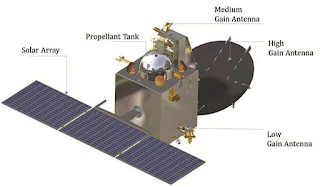ISRO scientists use Mangalyaan to look into Sun's atmosphere
 |
| MOM (Mangalyaan) |
ISRO scientists used the conjunction event of May-June 2015 – a time when the Sun's activity was quite low, to study the turbulence in the solar corona.
study the Solar Corona when the Earth and Mars were on the opposite sides of the Sun. Scientists used solar conjunction to look into the atmosphere of the Sun, which remains a complex mystery.
Scientists from Space Physics Laboratory of Vikram Sarabhai Space Centre, Trivandrum; Physical Research Laboratory, Ahmedabad; and ISRO Telemetry Tracking and Command Network (ISTRAC), Bangalore used S-band radio signals coming from Mangalyaan to study the Solar Corona.
Isro scientists used the conjunction event of May-June 2015 a time when the Sun's activity was quite low, to study the turbulence in the solar corona. The findings have been published in the journal Monthly Notices of the Royal Astronomical Society.
The Corona is the outer atmosphere of the Sun, where temperatures are several million degrees Kelvin, making it impossible for in-situ measurements, thereby challenging the experimenters. Scientists from the world over are trying to figure out the reason for such a high temperature of the corona, and study the solar wind that originates here. These winds are responsible for triggering geomagnetic storms on the inner planets, including Earth, creating dangerous conditions for humans to operate in space.
Isro said that the radio signals from MOM spacecraft crossing through the solar corona during the conjunction event (cf. Figure 2) consequently experience dispersive effects. The turbulence in the corona produces fluctuations in plasma density which are registered as fluctuations in the phase of radio waves passing through it.
These radio signals contain the signature of a propagating medium (solar corona) and can be spectrally analyzed to derive the turbulence spectrum of the medium. Isro scientists have obtained coronal turbulence spectrum at heliocentric distances between 4 and 20 R (1 solar radii (R) = 696,340 km). " This is the region where the solar wind primarily gets accelerated to velocities of a few hundreds of kilometers per second. The changes in turbulence regime are well reflected in spectral index values of the temporal frequency fluctuation spectrum," Isro said.



Comments